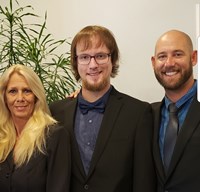Environmental Impact of Septic Syst...
Environmental Impact Of Septic Systems: Cautionary Tale Of The Indian
River Lagoon
Does your home use a septic tank system?
Typically, septic tank systems are installed in
homes which are too far away to be connected to a wastewater treatment plant.
Nearly 1 in 5 homes, along with countless businesses, churches, and other
installations — use septic systems as a convenient means of disposing
domestic waste.
When properly maintained, the environmental
impact of septic systems is minimal. But the problem is, while we are good
at installing new systems or even repairing broken ones, we fail to continually
maintain them.
Unfortunately, for Brevard County, Florida, home
of the Indian Lagoon River Lagoon, there are close to 82,000 permitted septic
systems. About 59,500 of those septic systems are
contributing to the slow-death of the Indian River Lagoon.
What is the Indian River
Lagoon?
The Indian River Lagoon (IRL) consists of the
Banana River Lagoon, Mosquito Lagoon, and Indian River. These bodies of water
are home a diverse eco-culture and connect Volusia, Brevard, St. Lucie, and
Martin Counties.
Historically, the IRL was home to a diversity of
rare and widespread species of fish, crabs, shrimp, and clams which gave it
clout as an international brand. This reputation brought tourism, increased
property value, and generated revenue through commercial fishing.
Here’s the problem:
These areas are now being threatened by storm
runoffs from urban and agricultural areas, excess fertilizer
applications, and septic system
pollution. This has become
clearly evident with the recent “Superbloom” in 2011 (an intense algal bloom in
Mosquito Lagoon, Banana River Lagoon, and North Indian River Lagoon). These
environmental issues have caused the diversity of species in the IRL to
deteriorate which has led to a decrease in property value and tourism.
Having said that, what role do septic systems
play in the current state of the Indian River Lagoon?
Why Septic Systems Need
Maintenance

INSIDE
OF A SEPTIC TANK
When properly
maintained, a septic system holds your waste on site until it can be broken
down by the naturally occurring microorganisms which live in the system.
Here’s how it works:
The waste in the septic system breaks down into
three parts:
1.
Scum
2.
Wastewater
3.
Sludge

LEACHING FIELD/DRAIN FIELD
The wastewater naturally filters over time
until it can be disposed into a drain field or leaching field (which is located
downhill from the tank).
This is a safe process, but many owners abuse their septic with inorganic
waste, hazardous chemicals, and excess water use. Because the system isn’t
showing physical signs of leaks or clogs, it is common for owners to mistakenly
think the system is having no problems. Instead of maintaining their septic,
owners will often wait until it is too late and the system needs to be
repaired.
Although you may not be seeing any issues, this
does not mean your septic tank is working properly. Here’s why:
The scum and sludge in your septic system
cannot be drained properly through the drain field. If you don’t pump or properly treat your system, scum
and sludge will build up. If not maintained or drained, buildup of sludge will
cause the waste water to drain too fast, and in worst case scenarios, the
sludge begins seeping out. These pollutants travel through the soil to
groundwater sources and can eventually lead to a body of water. New technology has
provided a more cost effective solution for maintenance (we’ll talk about that
soon).

If left untreated, the waste could rise up to
the surface and cause backups in your drains. At this point, your system has
completely failed. You will have to replace the drain field (a problem that can
cost $2,000 – $15,000) . So, what is the solution?
Finding a Solution to
Save the Lagoon
Across the United States, septic systems are
still a popular method for distributing waste. In the South Atlantic region of
the United States, more than 13% of new homes are being built with septic
tanks. In states such as Alabama, Mississippi, and Louisiana — that
number goes as high as 36%.
Within Brevard county alone, out of the -82,000
septic tanks in the area, it would cost $1.19 billion to convert 59,500 of the
problem-causing septic tanks to a central sewage system.
This is just economically unfeasible (especially
since septic tanks are only part of the issue). That’s why Brevard County has
decided to target septic systems with the highest potential for nitrogen and
phosphorus reduction as part of a series of initiatives:
1.
Fertilizer
Management and Outreach and Education – It is common to use fertilizer for agricultural uses.
However, when used in excess, these fertilizers pollute surrounding waters and
storm runoffs. That’s why it will be important to inform the public on
fertilizer and to affect regulations concerning this matter.
2.
Septic
System Removal and Upgrades – Both long term and short term opportunities have already
been identified. To create the maximum reduction of pollutants, the county
along with the Florida Department of Health will upgrade or remove septic tanks
based on low costs and high-impact.
3.
Surface
Water Remediation Services – The county will implement a water treatment solution that would
treat the water from Turkey Creek. It is estimated that this would remove more
than 90% of the suspended solids which are heavily attributed to the Indian
River Lagoon from Turkey Creek.
4.
Muck
Removal – The Muck in the Indian
River Lagoon depletes oxygen, inhibits sea grass growth, and destroys healthy
communities of benthic organisms (Trefry 2013). There will be a series of
projects conducted to remove this material.
To find out more, you can read the Save Our Lagoon Project Plan Here.
The Economic Upside of
Restoration
Brevard County stands to gain substantial
economic benefits from four areas:

1.
Tourism and Recreation
Growth
2.
Property Value Growth
3.
Rebirth of Commercial
Fishing
4.
Healthy Residents and
Tourists
According to the Save Our Lagoon Project Plan,
if viewing the plan as a purely financial investment, it would pay “$2 billions
in benefits alone.” And this does not account for the potential $4 billion loss
the area would suffer if no restoration were to happen.
What Can You Do To Help
Save Your Own Nearby Body Of Water?
If you own a septic system and are concerned
about the environmental impact it may have on the bodies of water around you,
here are some steps you can take which have been recommended by the Storm Water Center:
1.
Do not wait until you
see signs of failure from your septic system. Perform septic maintenance
regularly to reduce costs over the long term.
2.
Practice water
conservation indoors.
3.
Practice caution when
disposing of waste down the drain.
4.
Keep heavy equipment and
vehicles off your system and drainfield.
In addition, new technology has provided a
solution which will enable you to help your local environment and prevent
the devastating costs of pollution, all while avoiding expensive septic system
pump outs.
BiOWiSH Technologies is a company focused
on developing all-natural products. Our goal is to help rebuild and improve
living conditions around the world. If you own a septic system and
don’t want to spend money having a company pump out your septic system, we
have the perfect product for you.
Septic Rescue has been proven to fix failed septic
systems. By following a
simple 3 step process, you can avoid the hassle and headache of a septic system
pump out.
If your system is currently working properly,
it’s important to begin a regular maintenance. Septic
Tank Maintenance will ensure you never have to pump your septic
system again.
Septic Rescue and Septic
Tank Maintenance directly address
the environmental concerns seen in communities such as Brevard County. Both
products are proven to rapidly digest organic waste and eliminate odor
compounds. Using BiOWiSH™ Septic Products will provide a direct
benefit to your local environment.Reducing your contribution of nitrogen,
phosphorous, and other pollutants to the local ecosystem.





